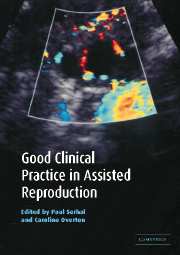Book contents
- Frontmatter
- Contents
- List of contributors
- Foreword by Bob Edwards
- Preface
- 1 Clinical assessment of the woman for assisted conception
- 2 Clinical assessment and management of the infertile man
- 3 Laboratory assessment of the infertile man
- 4 Donor insemination
- 5 Treatment options prior to IVF
- 6 Strategies for superovulation for IVF
- 7 Techniques for IVF
- 8 Ovarian hyperstimulation syndrome
- 9 Early pregnancy complications after assisted reproductive technology
- 10 Oocyte donation
- 11 Surrogacy
- 12 Clinical aspects of preimplantation genetic diagnosis
- 13 Controversial issues in assisted reproduction
- 14 Alternatives to in vitro fertilization: gamete intrafallopian transfer and zygote intrafallopian transfer
- 15 Counselling
- 16 Good nursing practice in assisted conception
- 17 Setting up an IVF unit
- 18 Information technology aspects of assisted conception
- 19 Assisted reproductive technology and older women
- 20 Ethical aspects of controversies in assisted reproductive technology
- Index
- Plate section
13 - Controversial issues in assisted reproduction
Published online by Cambridge University Press: 22 October 2009
- Frontmatter
- Contents
- List of contributors
- Foreword by Bob Edwards
- Preface
- 1 Clinical assessment of the woman for assisted conception
- 2 Clinical assessment and management of the infertile man
- 3 Laboratory assessment of the infertile man
- 4 Donor insemination
- 5 Treatment options prior to IVF
- 6 Strategies for superovulation for IVF
- 7 Techniques for IVF
- 8 Ovarian hyperstimulation syndrome
- 9 Early pregnancy complications after assisted reproductive technology
- 10 Oocyte donation
- 11 Surrogacy
- 12 Clinical aspects of preimplantation genetic diagnosis
- 13 Controversial issues in assisted reproduction
- 14 Alternatives to in vitro fertilization: gamete intrafallopian transfer and zygote intrafallopian transfer
- 15 Counselling
- 16 Good nursing practice in assisted conception
- 17 Setting up an IVF unit
- 18 Information technology aspects of assisted conception
- 19 Assisted reproductive technology and older women
- 20 Ethical aspects of controversies in assisted reproductive technology
- Index
- Plate section
Summary
Fibroids: remove, leave or embolize?
Fibroids are a frequent finding in women with infertility (Figure 13.1). Many clinicians who have performed myomectomy on infertile women have reported that the treatment is effective and increases the pregnancy rate. However, no randomized controlled trials have been performed to establish the causal relationship. In a review of the literature, Vercellini et al. (1992) concluded that fibroids do not cause infertility in the vast majority of cases.
Effective management of the woman with fibroids who wishes to conceive cannot yet be determined by an evidence-based approach using randomized controlled trials. However, it is clear that subfertility resulting from fibroids is not absolute and many women will conceive without intervention. It is sensible to ensure that other causes of infertility have been looked for and if present, treated appropriately in the absence of other causes of infertility. The couple is advised to try for at least two years to conceive naturally, unless the woman is aged 34 years or more, when more rapid intervention becomes advisable, given the negative impact of increasing female age on the likelihood of pregnancy, both naturally and after IVF and embryo transfer (IVF-ET).
Many women with fibroids have favourable obstetric outcomes but it is well accepted that the presence of myomas increases the risk of pregnancy related problems. Pregnant women with fibroids have an increased chance of developing pain, red degeneration, bleeding, premature labour, fetal malpresentation, need for operative delivery, retained placenta and postpartum haemorrhage. In a combined series of 1284 women with fibroids, 13% of pregnancies were complicated by premature labour (Rice et al., 1989).
Fibroids are classified according to site (Figure 13.2).
Keywords
- Type
- Chapter
- Information
- Good Clinical Practice in Assisted Reproduction , pp. 226 - 255Publisher: Cambridge University PressPrint publication year: 2004

